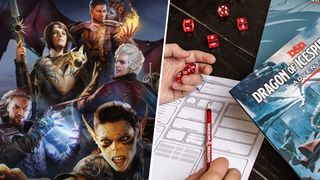Everything you need to know about DnD before playing Baldur's Gate 3
A crash-course on the pen-and-paper game that inspired the new RPG
Hang on, is Baldur's Gate 3 Dungeons and Dragons? And if so, what's the Baldur's Gate 3 DnD connection? Don't worry, we've got you covered. Our heads are full of all the answers after a long time spent playing both games, so you'll find a cheat-sheet on everything you need to know below. This will help you hit the ground running when it comes to Baldur's Gate 3.
That's because it isn't just based on the pen-and-paper RPG; it uses exactly the same mechanics, right down to combat. It's even set in the same world, with famous characters from the tabletop making appearances every now and then. Basically? Baldur's Gate 3 and DnD are two sides of the same coin.
With that in mind, you'll find a lowdown on classes, lore, gameplay, and more here. Getting a handle on one of the best tabletop RPGs will genuinely help you out in Baldur's Gate 3, so it's a good idea to get acquainted.
As for keeping the adventure going away from the screen, be sure to check out our guide to the board games and tabletop RPGs like Baldur's Gate 3.
The world of D&D and Baldur's Gate 3
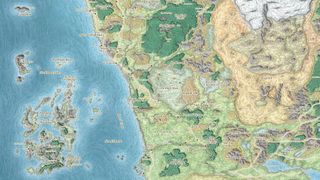
OK, first things first: Baldur's Gate 3, most Dungeons and Dragons books, and even Dungeons & Dragons: Honor Among Thieves take place in the same universe. This is called 'The Forgotten Realms' (or 'Faerun,' if we're talking in-universe) and it may as well be the definition of medieval fantasy. Plenty of unique ideas can be found lurking under the surface, but generally, it's classic stuff. That means you can tick elves, orcs, wizards, and the rest off your bingo list.
As for specifics, Baldur's Gate is a city found on a stretch of land called 'The Sword Coast.' Unlike the metropolises of Neverwinter and Waterdeep (which you may recognize from other video games) that lie further to the north, it's a cutthroat place. A bit like Gotham from Batman, actually. Imagine a fantasy version of that and you won't be far off.
Is there a D&D story I need to know?
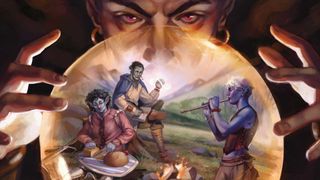
Is there an ongoing story you should be aware of when it comes to D&D? Fortunately, no. Although the game's been around for decades, its adventures usually stand alone despite being set in the same world. All you need to know is that nefarious forces (be they evil mages, dragons, or something equally nasty) plot our downfall on a regular basis.
Sign up to the GamesRadar+ Newsletter
Weekly digests, tales from the communities you love, and more
The same is true for Baldur's Gate 3. Your experience will be richer if you've played the previous two games, of course, but they're not necessary homework. This one takes place around a century later, and Minsc (a barbarian who's always accompanied by his 'miniature giant space hamster,' Boo) is the only returning character that's been confirmed so far.
The new game is a good place to start that doesn't rely on prior knowledge
Still curious? Basically, the first Baldur's Gate sees your character chased from their home and hunted across the Sword Coast for reasons unknown. Eventually, you discover that you, your pursuer, and numerous others are the secret spawn of a murder god called Bhaal, and the last one standing will gain their power. You stop this rampage and the world is saved (hooray).
The second game takes place shortly afterward, and you've been captured by a mage who's found out about your heritage... and intends to manipulate it. Basically, it's about your struggle to stop them.
Don't worry too much about all that, though. As we mentioned in our Baldur's Gate 3 review, the new game is a good place to start that doesn't rely on prior knowledge. In fact, it does such a good job that it's "primed to be held up with the best of the best."
D&D gameplay, and how it influences Baldur's Gate 3
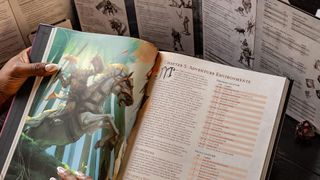
D&D isn't like the best board games; there are players, yes, but you also have a 'Dungeon Master' who's running it all. In essence, they're a blend of storyteller and referee. Along with setting the scene, leading you through a narrative, and controlling non-player characters, they react to what your party does by telling you whether your actions are successful or not (along with what happens next). These challenges are normally decided through rolling dice, adding a skill number to it, and seeing if you meet a target number.
Wondering how this applies to Baldur's Gate 3? Well, even though it's a video game, there is still a Dungeon Master. A narrator talks to you throughout the adventure as if you were playing pen-and-paper D&D, and you'll still roll dice for skill checks - it's just that your dice are all digital.
Dungeons & Dragons has always been turn-based, and the same is true of Baldur's Gate 3
Speaking of skills, these are carried over to Baldur's Gate practically untouched. When creating your character, you'll assign points to your core attributes - Strength, Dexterity, Intelligence, Wisdom, Constitution, and Charisma. These decide how good you are at particular tasks, and depending on how high the number is, you might receive a bonus when rolling certain skill checks (high Charisma offers a bonus on all persuasion rolls, for instance).
As per classic D&D, you won't be acting in real-time during combat either. Dungeons & Dragons has always been turn-based, and the same is true of Baldur's Gate 3. Once you enter a fight, you'll roll for Initiative to determine when you'll be able to act in relation to everyone else. Once it's your turn, you can then move, use an action (which is normally an attack, but doesn't have to be) and take a bonus action if any are available. These are often spells that you can cast as a freebie, so whether you get a bonus action or not will depend on your abilities.
Want more insight? Check out these Baldur's Gate 3 tips - they'll see you right.
D&D races used in Baldur's Gate 3
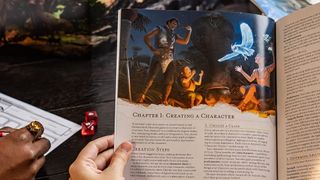
Although there are plenty of playable races in D&D, only the main ones from the core rulebook have been included here (well, along with a certain addition - we'll get to that later). You can check out the playable Baldur's Gate 3 races in our full guide, but here's the gist of it:
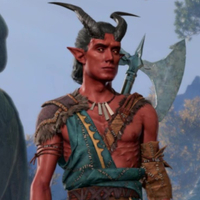
Tieflings: Humans whose ancestors were cursed by demons long ago, giving them badass horns and tails. They also have various demonic-related abilities (like the power to manipulate fire), so people don't like them very much. They come in a few varieties linked to different demons, and these basically boil down to what special power you want to have.
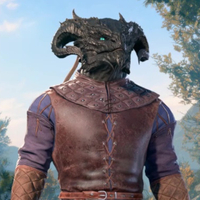
Dragonborn: Scaly lizardfolk who can breathe fire (in other words, they're pretty cool). Besides an awesome design, they come in numerous color varieties that impact more than aesthetics. Each one has a different breath weapon based on a unique element, so your 'subrace' will dictate whether it's lightning, poison, or something else entirely.
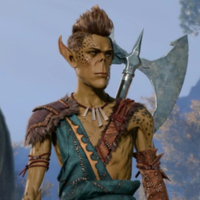
Githyanki: These are a D&D original, and they're an alien-like race from another plane of reality dedicated to hunting down Mind Flayers (those tentacle-faced monsters you'll see a lot of in Baldur's Gate 3). They didn't make it into the core D&D rules, so are an interesting addition here. While the Baldur's Gate version doesn't have any subraces to speak of, whereas the tabletop equivalent does.

Drow: An elven offshoot that typically dwells far underground, in a place called the Underdark. They've been depicted as 'evil' in the past, but that's starting to change nowadays. To reflect this paradigm shift, you can be 'Lolth-Sworn' (which means you serve the evil Spider Queen godess, Lolth) or a Selderine Drow, the latter of which reveres classic elven gods instead.
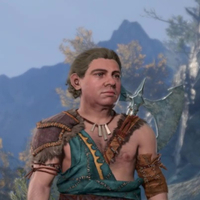
Halflings: Hobbits by any other name. As per tradition, they're brave, lucky, and very good at sneaking around (which makes them a great fit for stealth-based roles). There are two different kinds in Baldur's Gate 3 and D&D; the stealthy Lightfoot, or the resilient Strongheart. Both fit nicely with classic fantasy tropes, so you're well served if you want to create either something based on characters like Bilbo Baggins or Samwise Gamgee.
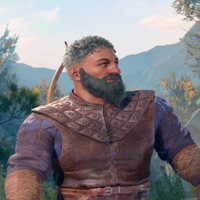
Dwarves: If you've encountered dwarves in any fantasy setting, you know what to expect here - those from The Forgotten Realms aren't much different. However, they do differentiate themselves with their subraces. You can choose to be a Gold Dwarf (which increases toughness), a Shield Dwarf (better with armor), or a Duergar (a gray-skinned variant descended from Mind Flayer experiments).
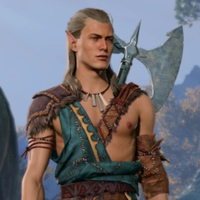
Elves (and half-elves): Your archetypal elf - but with the key difference that they're not immortal in this world (they just live for a really long time). Because elves are descended from the mystical Feywild, both D&D and Baldur's Gate 3 feature the same 'Fey Ancestry' trait that gives you advantage against being charmed. There are two subraces as well: the more magically inclined High Elves, or the athletic Wood Elves.
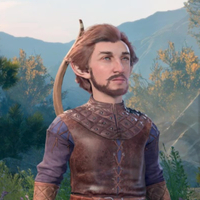
Gnomes: Master craftsfolk who excel at making magical doodads and cool technology. They're generally very cunning, and come with three subraces - Rock Gnomes, Forest Gnomes, and Deep Gnomes. The first are your bog-standard option, Forest Gnomes are able to talk with animals, and Deep Gnomes are gray-skinned variants that live deep underground.
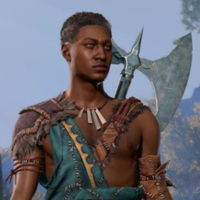
Humans: As with most fantasy worlds, humans form the bulk of the population here. If you want an all-rounder in either Baldur's Gate 3 or D&D, they're a great option. They don't have any subraces, but the video game version are very versatile and have the 'Civil Militia' trait that offers proficiency in lots of weapons and armor.
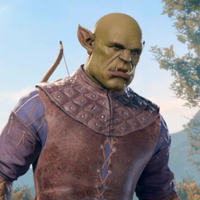
Half-orcs: While orcs aren't playable in Baldur's Gate 3 or standard D&D, half-orcs often fill the stereotypical role of warriors and beserkers (but there's no reason why you need to do the same). No matter what, they have a special 'Savage Attack' that deals a ridiculous amount of damage on a critical hit, and they're generally quite resilient.
It's possible that more of D&D's playable races will appear in Baldur's Gate 3 down the road, and many (like Bugbears) feature as non-playable characters during the story. However, these are the main ones you need to know about for now.
D&D classes in Baldur's Gate 3
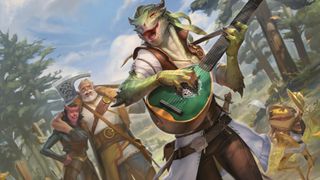
Because Baldur's Gate 3 uses the D&D system, it also translates all of the classes from the main rulebook into the game too. If you want a full rundown, check out our Baldur's Gate 3 classes list, but here's how they work in the broadest sense:
- Bard: Magical musicians that often fill a support role. Basically rockstars.
- Barbarian: Heavy-hitting beserkers who fly into a rage. They like to hit stuff.
- Cleric: Healers and warriors powered by faith. Very useful to have around.
- Druid: Shapeshifting mystics that usually live in the wilderness.
- Fighter: Your bog-standard warrior.
- Monk: Spiritual, hand-to-hand experts who channel an inner power.
- Paladin: The party's tank. Like the Cleric, they draw power from faith.
- Ranger: Kind of like Rogues, but often with pets.
- Rogue: Your classic sneak-thief.
- Sorcerer: Mages powered by an unknown - often uncontrollable - ability.
- Warlock: Mages bound by a pact with supernatural beings. Usually angsty.
- Wizard: Traditional spell-casters. May or may not have a pointy hat.
If you're curious, you can get a better read on these in our guide to the best D&D class for beginners.
And there you are - you should be all set to tackle the Forgotten Realms. While we're on the subject, how's it all going for the newest RPG on the block? Check in with our Baldur's Gate 3 release live blog. Want to try the pen and paper game, on the other hand? Here's how to create your first D&D character.

As the site's Tabletop & Merch Editor, you'll find my grubby paws on everything from board game reviews to the latest Lego news. I've been writing about games in one form or another since 2012, and can normally be found cackling over some evil plan I've cooked up for my group's next Dungeons & Dragons campaign.
Most Popular



